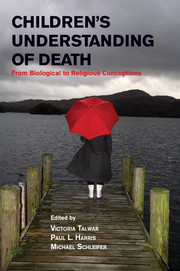Book contents
- Frontmatter
- Contents
- List of Figures and Table
- List of Contributors
- Preface and Acknowledgments
- 1 Death, Ancestors, and the Living Dead: Learning without Teaching in Madagascar
- 2 Death in Spain, Madagascar, and Beyond
- 3 Ambivalent Teaching and Painful Learning: Mastering the Facts of Life (?)
- 4 Death in the Lives of Children
- 5 Talking to Children about Death in Educational Settings
- 6 Responsible Believing
- 7 Thoughts and Feelings: Children and William James Have It Right!
- 8 How the Law Constructs Its Understanding of Death
- Index
- References
5 - Talking to Children about Death in Educational Settings
Published online by Cambridge University Press: 03 May 2011
- Frontmatter
- Contents
- List of Figures and Table
- List of Contributors
- Preface and Acknowledgments
- 1 Death, Ancestors, and the Living Dead: Learning without Teaching in Madagascar
- 2 Death in Spain, Madagascar, and Beyond
- 3 Ambivalent Teaching and Painful Learning: Mastering the Facts of Life (?)
- 4 Death in the Lives of Children
- 5 Talking to Children about Death in Educational Settings
- 6 Responsible Believing
- 7 Thoughts and Feelings: Children and William James Have It Right!
- 8 How the Law Constructs Its Understanding of Death
- Index
- References
Summary
Children are exposed to death at home, at school, and in the media. It has been estimated that approximately 4–7 percent of children experience the death of a parent by the time they are sixteen years old (Hogan & DeSantis, 1996; McCarthy & Jessop, 2005). Others will experience the death of a sibling, a grandparent, or other family member. The death of a loved one affects not only the child, but also has a ripple effect on the rest of the children in the classroom. Alternately, the class as a whole may experience the death of a member of the school community (e.g., teachers or staff) or the death of an individual in the media (e.g., Michael Jackson). In other cases, children may be exposed to the media reports of a national or global tragedy (e.g., the earthquake in Haiti). Children who experience death will have a range of reactions in a variety of settings, including school, where they spend much of their time (Corr, Nabe, & Corr, 2003). Thus, schools are a critical setting for children who are dealing with death and loss.
Talking to children about death is a common problem faced by educators who are confronted with children's questions. It is a challenging subject and one that is often ignored and avoided. Death is associated with negative feelings such as discomfort, sadness, anger, and fear. How someone speaks to children about death depends on that individual's own beliefs and attitudes.
- Type
- Chapter
- Information
- Children's Understanding of DeathFrom Biological to Religious Conceptions, pp. 98 - 115Publisher: Cambridge University PressPrint publication year: 2011
References
- 11
- Cited by



